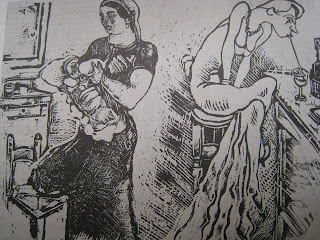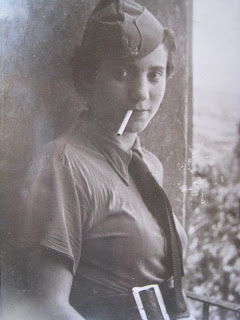 |
| John Galliano |
We were intrigued by Rhonda Garelick's op-ed piece in the March 7
New York Times on the unsavory conduct of John Galliano, Dior's weird and notorious creative director, who had been fired from his $5 million post a few days earlier for saying awful things in a Paris bar, La Perle. On one occasion--unfortunately for Galliano,
caught on a cellphone--he told a nearby woman "I love Hitler" and added, "People like you would be dead. Your mothers, your forefathers, would all be f....... gassed." In another bar rant, it was "Dirty Jewish face, you should be dead," followed by a critique of the woman's body and attire: "Your boots are of the lowest quality, your thighs are of the lowest quality. You are so ugly I don't want to see you. I am John Galliano!"
 |
A poster of Mussolini with the "right" sort of Italian
woman: plain, with child, humbly dressed |
Garelick takes the next step, connecting Galliano's vitriol to fascism's use of the fashion industry during the Vichy years of the 1940s, when French fashion fell under the sway of the Nazis and became a servant of Nazi and Vichy propaganda. "Our role," said one Vichy designer, "is to give France the face of serenity. The more elegant Frenchwomen are, the more our country will show the world that we are not afraid." Many French designers for women bought into Aryan ideals of youth, beauty, physical fitness and physical perfection--defined as blue eyes, blond hair, and "sharp-angled features"--that today, Garelick notes, can still be found in the work of Ralph Lauren and Calvin Klein. For Garelick, Galliano is a version of the "fascist demagogue of yore," using the simplest of measures--what one wears, how one looks, whether one is defined as attractive or not--to exclude and, in his fantasy, kill.
 |
At left, the Fascist ideal of womahood. At right, the threatening
woman: thin, dissolute, fashionable. 1931 |
The Italian experience is similar and different. Italian fascism was deeply concerned about women's bodies and dress, but more fearful than their French counterparts about the sexualized women's body, women's physical fitness, and high fashion. Concerned about "scandalous" dress, Mussolini's Fascists created a National Committee for Cleaning Up Fashion (1927-), which for two years worried about things like the skirt lengths of small-town girls. Unlike the French, fascism in Italy by-and-large rejected women who were too thin or pale, while valuing the "authentic woman," dedicated above all else to maternity, with her rounded figure and peasant costume ("in a narrow womb/the chick is doomed"). The Duce's Fascists were gung-ho about muscles and manliness and men's physical fitness, but exercise for women was another matter: no skimpy uniforms, no athleticism (the Olympics an exception), no male sports like soccer, nothing that might encourage lesbian relationships.
 |
Properly uniformed, but dangerously
emancipated. Siena, 1943 |
Fashion posed a particular problem for Italian fascism. During the early years of the Mussolini regime--through about 1933--high fashion was encouraged, but only for the country's social elite. In these years, there were fashion shows at the Excelsior and Grand Hotels in Rome, and in the Rose Casino of the Borghese Gardens, and even--in 1933--the first Permanent National Fashion Exposition in Turin--all of this applauded as an expression of the nation's elite--that is, the Fascists. By 1935 the tide had turned, and in 1938, as war approached, Mussolini launched an anti-bourgeois "reform of custom" that reviled luxury and top-down fashion and trumpeted the virtues of having as many women as possible in rough-wool uniforms (photo right) or, at least, wide skirts and shawls.
So, for Mussolini's Fascists, as for Dior's Galliano, fashion was a way to define who had value and who did not. In the 1930s, that decision could have unthinkable consequences. Today, probably not--just John Galliano, a little drunk and struggling with his own Jewish heritage, raving in a bar.
Special thanks to Victoria De Grazia, for material drawn from her outstanding book (cover photo above right), How Fascism Ruled Women: Italy, 1922-1945 (University of California Press, 1992).
Bill


No comments:
Post a Comment